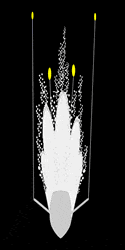WHY:
A basic premise when trolling lures offshore is that the boat itself attracts fish. The prop wash, foaming water, etc. create a disturbance visible and detectable by fish from quite a distance, both horizontally and vertically. The fish come to check out the disturbance, and see the trolled lures as either stragglers from a school of bait being attacked, or as unsuspecting smaller predators trailing a school of bait.
Lures should be positioned so that they are visible to approaching fish, and located where they would be expected to be – either to the side, behind, or behind and below the “bait school”. In small boats, especially those with outboard motors, the difficulty is finding spots to place the lures that are not too far back.
In larger inboard or sterndrive boats, the consensus is there are clear water “holes” in the wake in which lures can be placed, making them visible without being too far back. Outboards have a tougher time producing clean wakes, although there are tricks to improve things. In addition, there are some types of lures and certain types of teasers (such as spreader bars) which swim best when the line is coming from above. So the rationale for using outriggers in ocean skiffs is that they allow you to place lures away from the wake in clear water areas, and also allow things like spreader bars and certain lures to be used more effectively.
PROS: |
CONS: |
|
|
FACTORS TO CONSIDER:
Length & stiffness:
Longer, stiffer outriggers are more desirable. However, longer, stiffer outriggers are heavier, require heavier mounts, and can be more complex (many larger outriggers have guy wires and stays to keep the rigger straight). Most manufacturers make 12′ or 14′ “skiff outriggers” that are single fiberglass poles with simple rigging.
Materials & construction:
Tubular fiberglass or aluminum are the norm. Some fishermen feel strongly that aluminum and stiff riggers are a necessity to troll lures effectively. However, it should be noted that many larger Australian fishing boats use tubular fiberglass without stays, and troll large lures without a problem.
Type & location of outrigger mounts:
Gunnel, T-top, and bulkhead mounts are common. Outrigger mounts usually are designed to allow the ‘riggers to be turned 90 degrees, which, because of their construction, causes the ‘riggers to point straight up for travelling at high speed. Keep in mind that in an ideal world, outrigger mounts should be installed with backing plates and through-bolts.
Release clips:
Each outrigger will have one or more release clips. Release clips come in many styles, each trying to strike a balance between reliable release, ease of use, and release tension. Some clips are good at releasing under light pressure, some are not. Clips that release reliably under light pressure often can not be cranked up high enough for larger lures.
Halyard setup:
Halywards are the pulleys and cord setup used to move the release clips in and out. Most are braided dacron or mono line, with glass rings or pulleys on shock cord used to maintain tension. The most expensive outriggers will have pulleys with locks.
ALTERNATIVES:

What are some alternatives to outriggers?:
- The most popular alternative seems to be “rod riggers”. These are rod holders that fit into existing gunnel rod holders, and hold a rod sideways away from the boat – effectively using the fishing rod itself as a mini-outrigger.
- A spinoff of the rod rigger is a device called the “Flat Line Boom” This is a patented device from Pelinet, Inc., which mounts a 4′ or 6′ aluminum boom into the rod holder, instead of using the fishing rod. The Flat Line Boom incorporates a rod holder as well, but the rod is held vertically

- In some cases, it may not be practical or legal to use outriggers. For example, many people who fly fish for billfish do not use outriggers because they might catch the flyline. Instead, they use teasers on short flatlines and a single long fishing rod to work the active teaser. For people fishing in Mexican waters, you are only allowed one line per angler. In a small skiff, that means you may legally have only two or three lines out.
THE BOTTOM LINE:
Do outriggers help you catch more fish?
Under the right conditions, “yes”, but for small boat fishermen, the benefits may not outweigh the hassle of rigging and storing them. Alternatives exist which can be more effective under certain condition.
- People that do a lot of trolling tend to use outriggers more. People who use a combination of trolling and live bait, do not use outriggers as often.
- A general consensus is that they are not as necessary for tuna as they are for billfish, unless you are trolling specialized outfits like spreader bars or daisy chains. Outriggers on boats under 24′ are relatively rare.



